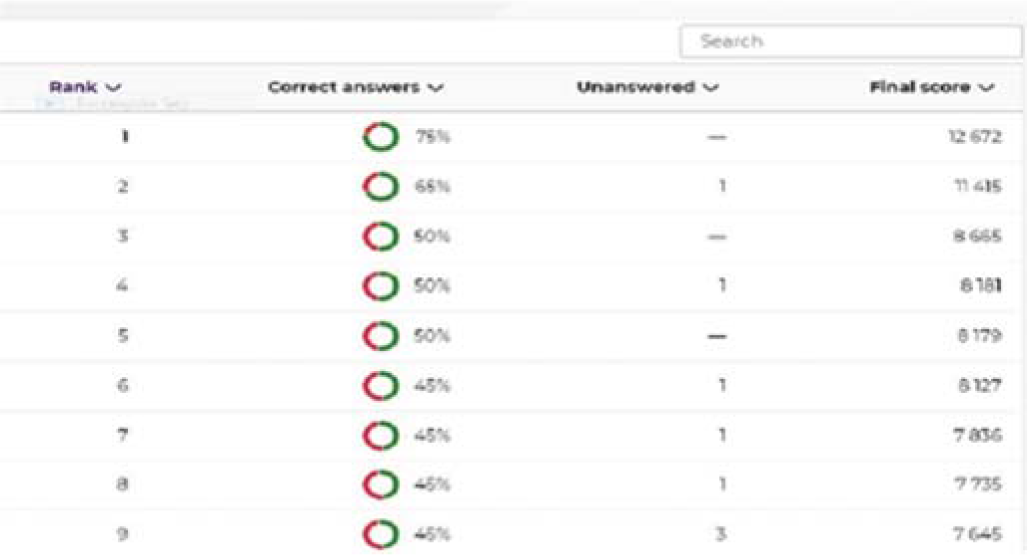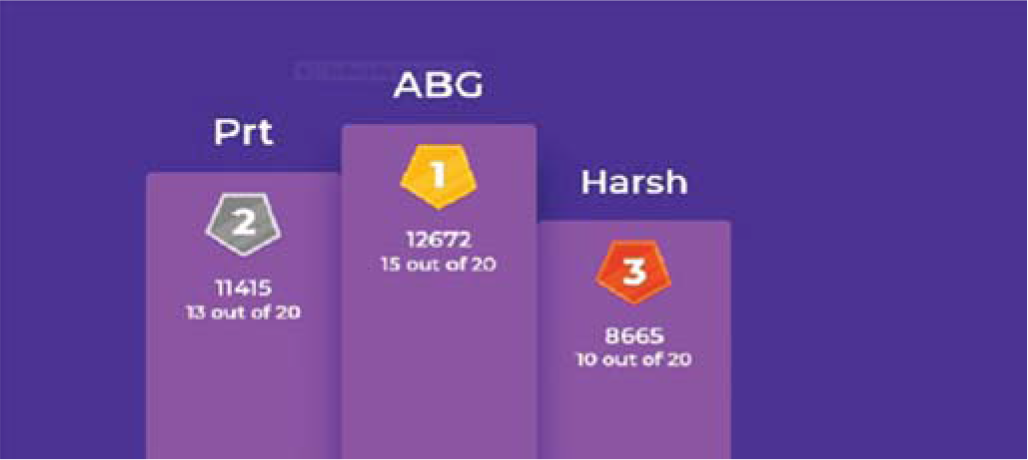Translate this page into:
Student feedback on the use of gamification for teaching pathology postgraduates
To cite: Garg N, Tanveer N, Dixit S. Student feedback on the use of gamification for teaching pathology postgraduates [Correspondence]. Natl Med J India 2021;34:375–76.
Gamification is a relatively recent approach to medical education which seeks to use the inherent addictive nature of online gaming positively. For a long time, online games have been discredited due to their addictive nature and sometimes offensive content. Kahoot! is an online quiz-based learning platform with over 70 million users worldwide. It allows teachers to create quizzes with a character limit of 120 characters. The students are supposed to respond to the questions within the time limit set by the teacher. The application then evaluates the responses and displays the leaderboard after every question. The final scores and the top three contestants are displayed at the end of the quiz.1
The contestants can attempt the quiz again on their own devices and improve their scores. The key features that make this quizzing game interesting are instantaneous results, an interactive interface, and the fact that the quizzes are available on the app for all contestants to practise later.1
According to Aktekin et al., the benefits of Kahoot-based closure program (after each anatomy lecture) are increased attendance and participation, and more attentive and enthusiastic students in the class.2 Felszeghy et al. used a Kahoot gamification program for teaching histology to medical and dental students and concluded that the learning process and participant satisfaction can be significantly improved by introducing Kahoot-based gamification programs in histology courses.3 Other similar quiz-based gaming applications available are Socrative, Doctor’s Dilemma, Quizizz, Quiz maker, Lesson up, Quizlet, and Canvas. ‘Ghost mode’ on Kahoot allows students to compete against their first attempt to improve their time.
Our study was conducted in May–June 2020 after enrolling first-, second- and third-year pathology postgraduate students of a tertiary care hospital in northern India. This research complies with the guidelines for human research and was conducted in accordance with the Declaration of Helsinki of World Medical Association. Informed consent was taken from the study participants and subject confidentiality was maintained.
A total of 24 of 30 postgraduate students participated voluntarily. The students were asked to download the application ‘Kahoot’ and ‘GoToWebinar’ on the same or different devices. The quiz was accessible on smartphones, tablets or personal computers and was hosted at a specified time once a week. A webinar link was provided to the students on the day of the quiz. The game pin was shared with the students by screen sharing on GoToWebinar. Each quiz consisted of 15 multiple-choice questions with four options each and one correct answer (Figs 1a and b). Only 20 seconds were allowed per question. The application awarded points to the contestants based on their accuracy and promptness in answering. The top five positions based on cumulative scores were displayed after every question and the top three contestants at the end of the quiz (Figs 1c and d). Each quiz was followed by a discussion, which was hosted on GoToWebinar with emphasis on difficult questions, i.e. with the most incorrect answers (which was also calculated in the application automatically).

- Examples of questions asked during the online quiz on Kahoot!

- An example of the final ranking of students with their scores summarized by Kahoot! at the end of the quiz

- An example of a podium displayed at the end of the quiz with rankings
Due to Covid-19-related duties, it was difficult for the students to attend all the five weekly quizzes. Despite this 15 students were able to attend four or more quizzes and only 3 attended two or less.
After five sessions, the students were asked to fill an online feedback form. Twenty-three of 24 students responded to the questionnaire. All the students (23/23) found the online quiz useful (Table I).
| Question | Likert scale responses | ||||
|---|---|---|---|---|---|
| 0 | 1 | 2 | 3 | 4 | |
| Did the online quiz help to cope with lockdown stress? | 30.4% | 43.5% | 26.1% | na | na |
| Did the quiz interfere with your daily routine? | 78.3% | 21.7% | 0 | na | na |
| How often did you use the Kahoot practice mode to improve your score after the quiz? | Never: 17.4% | Only once: 52.2% | More than once: 30.4% | na | na |
| On a scale of 0 to 4 how much did gamification enhance your retention of the knowledge? | 0 | 0 | 43.5% | 39.1% | 17.4% |
na not available
The intervention was well-received by the students. However, during the study, some problems associated with the use of Kahoot! came to light. There was a tendency to guess among the students due to the time limit imposed and extra credits for fast responders. There was also a fear of being exposed as a low scorer due to peer pressure. Since the group consisted of students of different batches there was always a fear of being outperformed by a junior student.
Gamification cannot be for everyone and it needs to be handled with care by medical teachers. Quizzing requires an element of guesswork, hence it is important to recognize that while it is nice to encourage competition by quizzes, one should not give the impression that guessing is being encouraged. The students also need to know that the purpose of using a quiz in the classroom, whether online or offline, is to have a lively atmosphere.
A big hurdle to the virtual or online teaching model is the inconsistent availability of fast-speed internet at all locations. However, the situation is improving with better 4G penetration in small towns and tier-2 cities.The time allotted to the students for each question needs to be thoughtfully addressed. If it is too long, the students can google the question and find the answer and if it is too short, they are likely to get frustrated. More complex questions requiring analytical skills cannot be asked on Kahoot! and similar quizzing platforms.4
Conflict of interest
None declared.
References
- The effect of using Kahoot! for learning—A literature review. Comput Educ. 2020;149:103818.
- [CrossRef] [Google Scholar]
- Using online game-based platforms to improve student performance and engagement in histology teaching. BMC Med Educ. 2019;19:e273.
- [Google Scholar]
- Gamifying education: What is known, what is believed and what remains uncertain: A critical review. Int J EducTechnol High Educ. 2017;14:e9.
- [Google Scholar]




